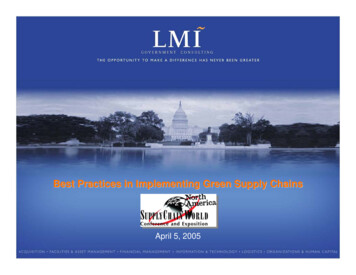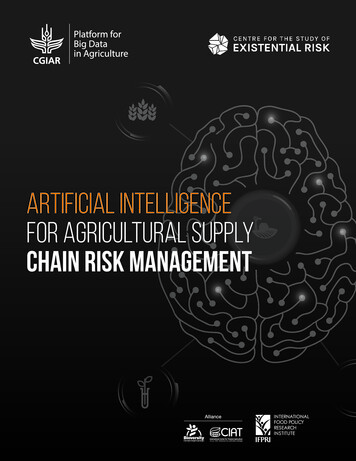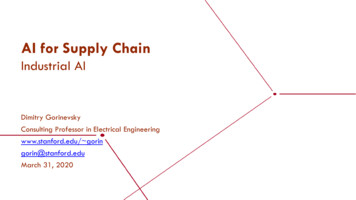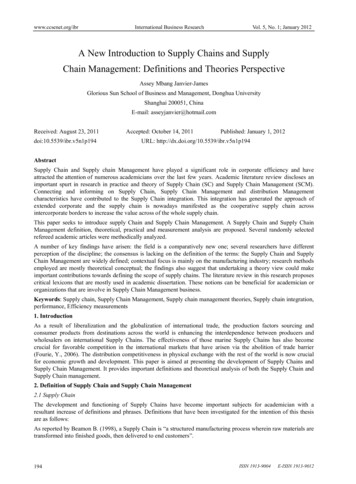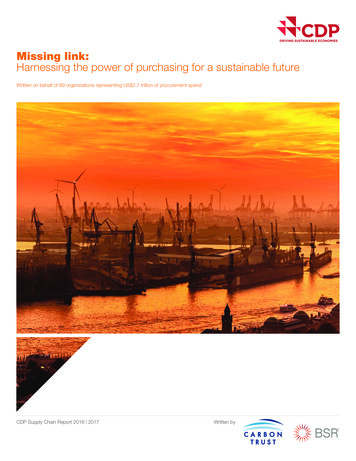
Transcription
Missing link:Harnessing the power of purchasing for a sustainable futureWritten on behalf of 89 organizations representing US 2.7 trillion of procurement spendCDP Supply Chain Report 2016 2017Written by
Contents3CDP’s supply chain memberorganizations25CDP Supply Chain – ForestsManaging Deforestation in the Supply Chain4Foreword from Patricia Espinosa266Executive summaryCascading change throughoutthe supply chain:Effective approaches towards sustainableand resilient supply chains8The Carbon Trust perspective3010Introduction:Engaging the supply chain is the keyto unlocking a sustainable futureA framework approach for reducingcarbon emissions and water impactsin the supply chain39Global commentarySupply chains: A missing link for sustainability40Supplier Engagement Ratings42The Supplier Climate & Water A-List47Acknowledgements12About this report14The state of supplier climate action:A stronger business case and a need fordeeper buyer-supplier engagement242Focus on China
CDP’s supply chain member organizationsIn 2016 the following 89 organizations engagedtheir suppliers through CDP. As CDP supplychain members they leveraged their US 2.7trillion of procurement spend to requestinformation from over 8,200 suppliers, onwhich the data in this report is based.Lead membersBank of AmericaDell Inc.Goldman Sachs GroupImperial BrandsJuniper Networks, Inc.JT International S/AL’OréalMicrosoft CorporationNorthrop Grumman CorpPepsiCo, Inc.Philip Morris InternationalRoyal PhilipsThe Coca-Cola CompanyThe Lego GroupWal-Mart Stores, Inc.Climate changeWaterAction exchangeCorporate membersAbbott LaboratoriesAccentureAcer Inc.Alliance Data SystemsAmdocs Ltd.Arcos DouradosAT&T Inc.Banco Bradesco S/ABarclaysBMW GroupBraskem S/ABridgestone CorporationBristol-Myers SquibbBritish American TobaccoBT GroupCaesars EntertainmentCaixa Econômica FederalCalifornia Department ofGeneral Services (DGS)CIA UltragazCisco Systems, Inc.CNH Industrial NVColgate Palmolive CompanyCSX CorporationDeutsche Telekom AGDiageo plcEaton CorporationEcoRodoviasElectronic IndustryCitizenship CoalitionEnagásEndesaFiat Chrysler Automobiles NVFord Motor CompanyGas Natural FenosaGeneral Motors CompanyHewlett Packard EnterpriseICLIntel CorporationItaú Unibanco Holding S/AJaguar Land Rover Ltd.Johnson & JohnsonJohnson ControlsKAO CorporationKellogg CompanyKPMG UKLos Angeles CountyMetropolitan TransportationAuthorityMetLife, Inc.METRO AGNational GridNestléNissan Motor CompanyNitto Denko CorporationNokia GroupPirelliPricewaterhouseCoopers LLPS.C. Johnson & Son, Inc.SABMillerSky plcStanley Black & Decker, Inc.SwisscomTaisei CorporationTD Bank GroupToyota Motor CorporationUnilever plcUnited States Departmentof the NavyU.S. General ServicesAdministration (GSA)Vodafone GroupVolkswagen GroupW.W. Grainger, Inc.Wal Mart de MexicoWorld Resources Institute (WRI)Santander Asset ManagementOurofino Saude AnimalSSE3
Foreword from Patricia EspinosaExecutive Secretary, United Nations FrameworkConvention on Climate ChangeAction on climate change has never been more necessaryor more achievable. Year after year we see the hottesttemperatures on record and the impact this has on theecosystems that sustain us all. Against this backdrop,the Paris Agreement has entered into force. This decisivestatement of intent, born of unprecedented globalconsensus, marks a truly meaningful step towards a lowcarbon future. The stage is set, the world is watching,now we must act.By raising awareness of thepositive aspects of supplychain action, it is possible todeliver tangible, meaningfulresults for the bottom line andthe planet.Effectively addressing climate change requires actionacross the supply chain. Millions of businessesoperate within the complex supply networks ofthe world’s biggest purchasing organizations, andgreenhouse gas emissions within the supply chain areoften at least four times greater than those from directoperations. Amidst increasing climate policy, investorawareness and consumer engagement, competitivecompanies increasingly look to their supply chain toreduce negative environmental impacts from businessactivity and realize more sustainable practices.By raising awareness of the positive aspects ofsupply chain action, it is possible to deliver tangible,meaningful results for the bottom line and the planet.Many innovations that reduce impacts are available.CDP supply chain data is testament to theresourcefulness of global suppliers to reduce theirgreenhouse gas emissions and water footprint whilebenefitting the business, customers and communities.Savings of USD 12.4 billion in 2016 were reported bysuppliers, proving that action on climate change andwater is not only the right thing to do, but the smartthing to do.By shining a light on leading company practices, thisreport provides insight into the evidence for action.It also highlights the tools and practices needed todeliver positive outcomes by taking greater actionoutside the direct operations of global companies.With the help and authority of the Supply ChainMember companies, CDP collected data from morethan 4,300 suppliers around the world in 2016. Eventhough this is the largest data set ever gatheredby the CDP supply chain program, many suppliersaround the world still lack awareness of the risks andopportunities that climate and water issues pose totheir business and customers. Only 22% of supplierorganizations that responded to the 2016 CDP SupplyChain information request actively engage with theirsuppliers. It is not enough.4I applaud the public and private sector purchasingorganizations that are taking climate action to theirsupply chains. It is encouraging to see the power ofaddressing climate change in supply chains. I alsocongratulate the companies highlighted by CDP asleaders on climate action in the first-ever Supply ChainEngagement Rating.
5
Executive summary4:1average ratio of indirectsupply chain emissionscompared to directoperational emissionsThe supply chain is the new frontier in environmentalresponsibility – an area rich with opportunity that remainsmostly unexplored, where a number of pathfinders arestarting to show others the value that can be found.Large public and private sector organizations haveenormous purchasing power, often engaging withthousands – or tens of thousands – of direct andindirect suppliers. By harnessing the power of theirprocurement decisions it is possible for them tocascade their own commitments throughout thesupply chain.Among these large organizations there is now abroad recognition that within their vast, complex andsometimes opaque supply chains there are a numberof sustainability challenges, resource risks, andefficiency opportunities. But despite this awareness,most have not been taking sufficient action toaddress them.However, this is starting to change. Today a growingnumber of leading organizations, such as CDP’ssupply chain members, are developing an emergingbody of knowledge and best practice on how toincrease visibility and have a positive impact on theirsupply chain. Sharing these effective strategies aswidely as possible could be the missing link in creatinga sustainable, low carbon economy.Supplier disclosedreductions equivalent to434milliontonnesof CO2 with associatedcost savings ofUS 12.4billionSustainability needs to move beyond organizationalboundaries into the supply chain.The science tells us that the world is facing veryserious environmental challenges, which are alreadybeginning to have a negative effect on humandevelopment and the economy. It also tells us thatthe collective sum of action today leaves us well offthe necessary trajectory to mitigate the mostdangerous impacts.Suppliers increasingly recognize their climate riskexposure. Three-quarters of the 4,366 suppliercompanies that responded to the questionnaire sentby CDP on behalf of its supply chain members thisyear report significant climate risks, and 62% expectclimate-related impacts on their business within thenext six years.The positive case for action is becoming increasinglycompelling, especially when it works in parallel withimproved operational efficiency. But despite thefact that 68% of respondents recognize positiveopportunities from action on climate change, theoverwhelming majority of businesses appear to befocusing their sustainability efforts exclusively on areasthat are within their own direct control and not yetengaging with key suppliers, customers and otherstakeholders.Fewer than half of the suppliers in 2016 report costsavings from emissions reduction activities, but thosewho do are realizing substantial savings – and theseinvestments will continue to pay back for years tocome. These leading suppliers disclosed reductionsequivalent to 434 million tonnes of carbon dioxidefrom reduction projects, an amount greater thanthe annual emissions of France.1 This resulted in areported US 12.4 billion in savings, more than doublethe figure from 2015. But it is likely that the full totalincluding unreported savings significantly exceeds thissum. And this may only be the beginning.However, supplier efforts are still insufficient to tacklethe scale of the challenge of climate change. Indeed,only 34% of suppliers report an overall year-on-yeardecrease in their operational emissions, with a further36% having insufficient data to track progress.Unfortunately, only 22% of supplier respondents arein turn engaging with their own suppliers to reducecarbon emissions. And just 4% have put supply chaincarbon emissions targets in place. This is a challengebecause – although it varies significantly acrosssectors – on average an organization’s supply chainemissions are four times greater than those fromdirect operations.1 UNFCC (2016). GHG emission profiles for Annex I Parties and major groups. United Nations Framework Convention on Climate Change, Bonn.Available at: http://di.unfccc.int/Annex1.aspx6
Only22of companies reportingto CDP’s supply chainprogram are workingwith their own suppliersto reduce emissionsThere also appears to be a general lack ofunderstanding and maturity on how to addresssupply chain impacts, when compared to mitigatingthe impact of direct operations. Even among CDP’ssupply chain members, all of whom are makingimpressive efforts to act on supply chain sustainability,only 27% have put in place specific supply chaincarbon emissions targets. This is an emerging areaof opportunity, even for those companies that havetraditionally been sustainability leaders.Harnessing the power of procurement andeffective interventions for changeWhen looking at water it appears that awareness ofopportunities and risks, as well as levels of action,lag some way behind climate change. For example,while more than two-thirds of supplier respondentsto the supply chain program saw climate changeopportunities, only 36% of suppliers respondingto CDP’s water program identified water-relatedopportunities. And only 28% see any water risksto their business, which compares to three-quartersthat see climate change risks.CDP’s 89 supply chain members collectively representUS 2.7 trillion in procurement spend, an amount thatis broadly equivalent to the economy of the UnitedKingdom in 2016.2The commitments made by large organizations onwater are also not cascading through the supplychain. Of the 607 respondents to CDP’s Investorled water program in 2016, only 38% required theirkey suppliers to report on water use, risks andmanagement. And when members cascaded theCDP request to their suppliers, only 16% of 1,260responding businesses disclosed that they in turnask their own suppliers to report on water use.US 2.7trillionannual procurementspend of 89 CDPsupply chain membersThe overall picture that emerges is that thesustainability commitments and practices ofleading organizations are not being replicated atscale downwards through the supply chain. Andeven among leading organizations, there is acomparative immaturity in strategies to addresssupply chain impacts when compared with theiraction on direct impacts.This suggests that many may not yet fully grasp howthey can benefit from efficiency and sustainabilityopportunities in their supply chain. Or they may lackthe strategy, organizational resources or capability totake advantage of them at present. In many cases,companies have a multitude of relevant effortsunderway, but they are not yet formalized into anintegrated strategy.Given the urgency of the world’s environmentalchallenges, there is a real need to find systemic leversthat can be used to deliver wide scale change atspeed. One of the most promising routes fordelivering this transformation is harnessing thepurchasing power of big buyers, who can collectivelyhave an enormous impact on the sustainability of theirextensive supply chains.Influence needs to go beyond setting a good exampleof how to measure and manage direct environmentalimpacts. While there are no universally effectiveapproaches to taking action within the supply chain,there is now a growing awareness of the strategiesand types of interventions that can be successful inpromoting supply chain sustainability. However, thesedo need to be adapted within industries, to take intoaccount various technical, practical and financialissues that can arise.Examples of these potential interventions wouldinclude: supplier development and collaboration onsustainability programs; working with competitors andstakeholders to collectively set industry standards; andtransforming product offerings or business models toengineer out downstream environmental impacts.Building on previous years, this 2017 report goesbeyond setting out the current state of action fromsupplier respondents and members of the CDPsupply chain program. It sets out a framework foraction within the supply chain, illustrated with casestudies and examples of how organizations are takingaction today.This year also sees the launch of CDP’s new SupplierEngagement Rating, recognizing the organizationsthat are demonstrating real leadership and bestpractice in working with their supply chains on climatechange. While this year the ratings only include arelatively small number of companies that rate highly,in the near future all companies will be included toidentify those that are not yet working on supplychain impacts.2 IMF (2016). World Economic Outlook Database. International Monetary Fund, Washington DC.Available at: odata/index.aspx.7
The Carbon Trust perspectiveChief Executive of The Carbon Trust, Tom DelayThere is now common consensus that we face majorenvironmental challenges. Our response today toissues such as climate change, water scarcity anddeforestation will very much determine the future ofthe planet. If we get it wrong, then many will directlysuffer serious consequences from the negative impacts.Indeed, some are already feeling the effects.Organizations are finding newand creative ways to expresstheir sustainability ambitions,working on exciting projectsthat can only be achievedthrough collaboration, anddiscovering how to find realvalue by going outside of theirboundaries and areasof comfort.And we are responding. There are many reasonsto be positive. There is a clear global framework of17 interrelated Sustainable Development Goals. Wehave an international agreement on climate change.Businesses and governments are making individualand collective commitments to act boldly. They maynot be perfect, but they come a lot closer to whatwe hoped would be possible than we feared mightbe the case.It is good progress, but it is still not enough. We aremoving in broadly the right direction at too slow aspeed. The question is how can we accelerate actionto the levels required?We believe that large public and private sectororganizations are a big part of the answer. They bringtogether the productive capabilities and access tocapital that can change the world at scale and atspeed. Most importantly, they also have the powerto multiply their own impact many times over byengaging their supply chain.With very few exceptions, the supply chain representsthe biggest area of sustainability impact andopportunity for a business. But like many of the mostrewarding large-scale opportunities, it is not easy toturn the principle into a reality. It requires an ability tounderstand complex systems, a clear strategy, goodmanagement of resources and relationships, andabove all a willingness to invest and patience. Butthose organizations that master the art will find it canbe a profitable pursuit.8This will require new techniques. Working in the supplychain is like wielding a paintbrush with an extremelylong handle – the further away you try to make yourmark the more difficult it is to do it in detail. So thestrategies for engaging with the supply chain arenecessarily quite different to ones that you mightuse to reduce the environmental impact of your ownoperations. They require broader brush strokes.Today we are starting to see the art of workingin the supply chain turn into a wider movement.Organizations are finding new and creative ways toexpress their sustainability ambitions, working onexciting projects that can only be achieved throughcollaboration, and discovering how to find real valueby going outside of their boundaries and areasof comfort.However, if we are to properly address the hugeenvironmental challenges the planet is currentlyfacing it will take more than a new movement. It willrequire a revolution. And that will require innovativeleaders who inspire others to transform our currentlyunsustainable system.Large organizations, such as the members of the CDPsupply chain program, are one of our best hopes forcreating the changes we will need. Through this reportwe hope that our framework for action, alongside realexamples of their supply chain interventions being putinto practice today, will inspire others to implementsimilar strategies and help accelerate our collectiveprogress towards a sustainable, low carbon economy.
9
Introduction:Engaging the supply chain is the keyto unlocking a sustainable futureThere is now overwhelming international agreementon the urgent need for action on the challenges ofclimate change, water scarcity and deforestation.The big questions are no longer about what ishappening to the planet as a result of human activitynor why we should care. Instead the questions relateto how we can deliver change, and when we needto do this by to avoid unacceptably damaging ordangerous consequences.2016 was by some distance the warmest year inmodern history, with temperatures more than 1 Cabove the pre-industrial average. Concurrently, therehas been a lot of positive progress on the climate overthe past 12 months.Momentum is building. The Paris Agreement onclimate change was ratified, making it one of thefastest ever global deals to enter into force, supportedThe sum of all current commitments leavesthe world on a trajectory towards around 3.4 Cof warming.3 At the same time we are seeingindicators of major resource risks. Businessesreporting to CDP have disclosed US 14 billionof water-related financial impacts. And CDP’sGlobal Forests Report highlights US 906 billionof revenue at risk from deforestation, particularlyaffecting key commodities such as palm oil,cattle, soy and timber.by over 200 businesses that have now set their ownscience-based targets to align with a 2 C goal. Therehas recently been a major deal on issues that havepreviously resisted attempts at agreement, such asrefrigerants and aviation emissions. The G20 hasreleased a landmark report on climate-related financialdisclosures, recognizing at the very highest levelsthe risks that climate change poses to the globalfinancial system.However, better is still not good enough. The sumof all current commitments leaves the world on atrajectory towards around 3.4 C of warming.3 At thesame time we are seeing indicators of major resourcerisks. Businesses reporting to CDP have disclosedUS 14 billion of water-related financial impacts. AndCDP’s Global Forests Report highlights US 906 billionof revenue at risk from deforestation, particularlyaffecting key commodities such as palm oil, cattle,soy and timber.In most cases governments openly recognize the risksposed by these challenges, but are still not acting in amanner consistent with sufficiently addressing them.The general public and small businesses have theirattention focused on the needs of today. But largeorganizations – both in the private and public sector –are a potential bright spot in the wider picture.These organizations are large employers, creators ofeconomic value, and providers of essential services.They have skills and resources, access to a wealth ofinformation, and the ability to manage complexity andrisk. They see genuine opportunity and competitiveadvantage in improving sustainability.What is more, they have commercial relationships withthousands of businesses in the first tier of their supplychain, where there is typically a far greater potentialfor sustainability improvements than within their ownoperations (see Figure 1). Getting a critical mass ofthese large organizations to engage their supplierson sustainability could be one of the best availablesolutions to the puzzle of creating a sustainable, lowcarbon economy.The opportunity for influence is significant, but todo this, commitments need to cascade effectivelyupwards through the tiers of the supply chain. Ascustomers increasingly demand transparency,accountability and extended responsibility well intosupply chains, the reputational risks and opportunitieshave never been greater. The lack of progress to datecan be explained by the fact that supply chains areglobal, occasionally opaque, and difficult to influence.A new toolbox is required, often using approachesthat have only become available recently thanks tomodern technology and big data.3 UNEP (2016). The Emissions Gap Report 2016. United Nations Environment Programme (UNEP), Nairobi.10
This report also sets out the current state ofsustainability performance climate change and waterfor suppliers of CDP supply chain members, followedby a perspective on what the members themselvesare doing. In addition, the latter section includes aframework developed by the Carbon Trust settingout a process for companies to follow in order tocatalyze change within their supply chains. This isillustrated with initiatives currently being implementedby members of CDP’s supply chain program,providing practical examples of implementationand lessons learned.Real practical examples and case studies are neededto show companies how they can find the value inpushing their own suppliers to reduce their impact, orchanging external conditions so that there is a marketpull towards providing more sustainable products andservices. Leaders are deploying commercial incentivesfor sustainability, minimum procurement requirements,and fostering supplier collaboration.The good news is that there are now a number ofleaders showing the way forward. This emerging bodyof practice is being highlighted for the first time thisyear by CDP through recognizing large organizationsthat demonstrate leading performance on its SupplierEngagement Rating (see page 40). This is featuredalongside the annual list of suppliers that have madeit onto the CDP Climate and Water A List for their ownperformance (see page 42).Figure 1. Proportion of total carbon emissions saving opportunities identified byCDP supply chain members and their suppliers by sectorPotential Member Carbon Savings and Total Potential in the Supply ChainMember InitiativesSupplier caaltHeConsFinancial0%11
About this reportThe report uses CDP’s supply chain program data submissions to evaluate the state of climate resilient supplychains, and to identify measures that purchasers can take to enhance supplier and supply chain resilience.The CDP supply chain program, representing 89 member organizations with US 2.7 trillion in annualprocurement spend, requested that suppliers report to members on their climate and water risksopportunities. Suppliers responded to standardized questionnaires: a full climate change questionnaire(“full questionnaire”) or a shorter version (“SME questionnaire”) for small and medium-sized enterprises(SMEs, or organizations with fewer than 250 employees and annual turnover of less than US 50 million orEUR50 million), as well as a water questionnaire.The number of suppliers participating in CDP’s climate supply chain program has once again grownsignificantly over the past year. Requests were distributed to 8,180 suppliers in 2016. The total number ofsupplier respondents increased by 11% from 3,932 in 2015 to 4,366 in 2016, of which 981 were SMEs.36% of the respondents were from the US, 27% from Europe, 9% from Japan, 7% from Brazil, 6% fromChina, and 15% from other parts of the world. Similarly, the number of suppliers responding to the CDPsupply chain water questionnaire has seen a steep 51% increase from 833 in 2015 to 1,260 in 2016.Although the participation rate increased from 51% in 2015 to 53% in 2016, the gap in supplier disclosureon climate remains a critical issue. The number of suppliers reporting to CDP for three years or moreincreased by 17% in 2016, and the returning respondents increased 12% over 2015, highlighting the valuethey are seeing in ongoing reporting on climate. The program continues to welcome a large number offirst-time reporters; the number of first year respondents increased from 1,258 in 2015 to 1,367 in 2016.The Carbon Trust and BSR used the information provided to assess key measures of supplier resilience,summarized in the table below. Information gathered from CDP supply chain members and their supplierswas used to evaluate the activities of suppliers reporting to CDP as a group, and to identify actions thatsuppliers and purchasers can take to encourage greater supplier resilience.Key CDP questionnaire data analyzed in the reportCharacteristic12CDP dataUnderstanding climate- andwater-related risks andopportunitiesIdentification of regulatory, physical, or other risksRisk likelihoodRisk magnitudeIdentification of regulatory, physical, or other opportunityManaging climate- andwater-related risksHighest level of direct responsibility for climate change (e.g. board level)(full questionnaires only)Incentives for management of climate change issues(full questionnaires only)Risk assessment and management procedures (full questionnaires only)Integration of climate change into business strategyActive emissions reduction targetsEmissions reduction initiativesEmissions reduction savings and project payback periodEngagement with suppliers, customers, and other partnersReporting, GHG emissionsmeasurement, andGHG reductionReported to CDPScope 1, 2 and 3 emissions measured and completeness of footprintGross emissions increase/decrease (full questionnaires only)Emission reduction targets and initiatives to achieve reductionsEngagement with suppliersSupply chain engagement by suppliers in water and carbonAllocation of emissions by suppliers to customers and identification ofreduction opportunities
Supplier CDP climate change participants,by number of years reportingThe CDP supply chain program continues towelcome new suppliers. Nearly a third of suppliers areparticipating for the first time, while about half of CDPsupply chain participants have been reporting for threeyears or more.31% First year19% Second year50% Third year plusIntel: working with CDP to formalizeengagement with suppliers onenvironmental reportingIntel recognized that partnering with suppliers is key to cascading action on sustainabilitythrough its supply chain. To engage its supply base more effectively on environmental reportingand performance, the company added a requirement to complete CDP’s climate changequestionnaire to its Program to Accelerate Supplier Sustainability.It was important to the company that it use an existing global standard to maximize the reportingbenefit to Intel and its suppliers, at the same time as minimizing the reporting burden placed onsuppliers who are responding to multiple customers. Intel’s engagement followed a three-stepapproach: (1) Building CDP reporting expectations into their supplier scorecards for its leadingsuppliers; (2) Making participation an eligibility requirement for Intel’s prestigious and publicSupplier Continuous Quality Improvement Awards; (3) Supporting suppliers through regularcommunications and webinar training.In 2016 Intel achieved a 96% response rate to CDP’s climate change questionnaire amongits leading suppliers. This supported Intel in attaining a Leadership (A-) score for the inauguralSupplier Engagement Rating. Of these suppliers, 47% responded for the first time and 30%only had a request from Intel. This strong participation will help the company continuouslyimprove its supply chain transparency and environmental performance. Next year the companywill expand requirements to include the CDP water questionnaire and encourage publicdisclosure of both surveys.13
The state of supplier climate action:A stronger business case and a need fordeeper buyer-supplier engagementOver two-thirds of suppliers identify opportunitiesrelated to climate change, translating into aggregatesavings among responding suppliers of US 12.4billion realized from emissions reduction projects –double the savings reported in 2015. However, onequarter of suppliers remain unable to identify theirclimate risks, and two-thirds are not able to reportquantifiable emissions reductions. Even in the contextof regulatory uncertainty on climate, suppliers candrive further progress that benefits their businesses,their customers, and the climate.Suppliers can play a key role in implementing theclimate action agenda whi
lag some way behind climate change. For example, while more than two-thirds of supplier respondents to the supply chain program saw climate change opportunities, only 36% of suppliers responding to CDP's water program identified water-related opportunities. And only 28% see any water risks to their business, which compares to three-quarters





